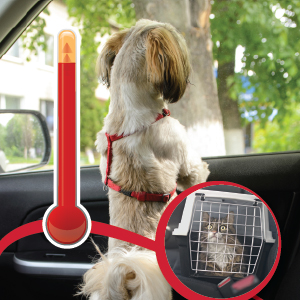By Patrick Noll, Director of Humane Law Enforcement & Humane Police Officer, HSHA
It is summer time in Pennsylvania! While there are many things that are very different this year, one thing remains unchanged: high temperatures and humidity. We feel it whenever we walk out of the door, and you had better believe our pets feel it, too. Most pet lovers are aware of this and will take the proper precautions to protect our dearest companions. However, this doesn’t mean that everyone will take the risks of the heat seriously, and a pet may need a concerned citizen to intervene.
high temperatures and humidity. We feel it whenever we walk out of the door, and you had better believe our pets feel it, too. Most pet lovers are aware of this and will take the proper precautions to protect our dearest companions. However, this doesn’t mean that everyone will take the risks of the heat seriously, and a pet may need a concerned citizen to intervene.
One of the situations you may need to step up and take action is when a dog is left in a hot car. The owner may have had the best intention when they decided to not leave their friend at home, but the result is the same: the dog is left waiting in a potentially dangerous situation. A car in the heat- especially in direct sunlight- can become unbelievably hot in a very short period of time. A 70 degree F day can bring the heat of a car up to 120 degree F within an hour. 90 degree F cuts that time down drastically, possibly reaching 110 degree F in as short as 1 minute. As the heat and humidity grows, that risk becomes more and more unbearable, and studies have shown that cracking the window about an inch or less helps very little.
These types of situations can be very emotional when you find yourself addressing it, especially for an animal lover such as yourself. You will want to help as much as you can, so let’s talk about some of the things you will want to know now, so you can be prepared if the time comes to act.
The first thing you want to do is stop and observe. As a rule of thumb, you never want to rush in or jump to conclusions. You want to know what factors to take into account, even if there is a clear and present emergency. The most important factors will be:
- The Dog’s Condition: First, take a moment to assess the dog’s behavior. Does it appear normal? Is it panting, laying on its side or frothing? The dog’s condition and behavior will let you know whether it is time to leap to action or time to stop and watch. If the dog appears be in distress, get an accurate description of the car along with a license plate number and call the local law enforcement immediately.
- The Type of Dog: It is also wise to note what type of dog you are looking at. Northern breeds such as huskies and malamutes do not tolerate the heat well, while dogs with pushed in noses like pugs, frenchies and boston terriers cannot breathe as well to cool down. Chubby dogs are also higher risk because of the extra layers.
- The Car: Is the car in the direct sunlight? Are the windows cracked at all, or even open (which is a whole other issue with an unattended dog)? Is the car running, possibly with the air conditioning on? There may be little cause for concern if the car is running in the shade, while a dog in a sealed car in direct sunlight has much less time before the conditions become dangerous.
 Using these factors, you will be able to determine how to respond. As previously stated, get on the phone right away with law enforcement if the dog is in distress. Have local stores use their intercom to page for an owner until the police arrive.
Using these factors, you will be able to determine how to respond. As previously stated, get on the phone right away with law enforcement if the dog is in distress. Have local stores use their intercom to page for an owner until the police arrive.
If the dog is not in distress but the conditions are still concerning, start taking notes. Write down the time when you first saw the dog, the current temperature, the description of the car and the license plate number. Observe the dog for at least 15 minutes, paying attention to the dog this whole time to ensure that its condition does not worsen. If the owner does not show up by that time, call the police so that they can address this further.
Please note: Pennsylvania did pass a law protecting law enforcement and first responders who break a car window in the event of an emergency. A citizen, however, does not have such clear protection. For this reason, it is imperative that you get help from police right away if there is an active emergency.
So that is the basics of a dog in a hot car. You may still have questions, and we want to be here to help sort them out for you. Please feel free to call in to the shelter and ask to speak with a member of the Cruelty Department.
*Images credit to Pennsylvania AAA Federation
